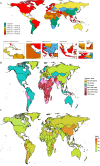Global, regional, and national burden and trends of migraine among youths and young adults aged 15-39 years from 1990 to 2021: findings from the global burden of disease study 2021
- PMID: 39134934
- PMCID: PMC11318134
- DOI: 10.1186/s10194-024-01832-0
Global, regional, and national burden and trends of migraine among youths and young adults aged 15-39 years from 1990 to 2021: findings from the global burden of disease study 2021
Abstract
Background: Migraine, a widespread neurological condition, substantially affects the quality of life, particularly for adolescents and young adults. While its impact is significant, there remains a paucity of comprehensive global research on the burden of migraine in younger demographics. Our study sought to elucidate the global prevalence, incidence, and disability-adjusted life-years (DALYs) associated with migraine in the 15-39 age group from 1990 to 2021, utilizing data from the Global Burden of Disease (GBD) 2021 study.
Methods: Our comprehensive study analyzed migraine data from the GBD 2021 report, examining the prevalence, incidence, and DALYs across 204 countries and territories over a 32-year span. We stratified the information by age, sex, year, geographical region, and Socio-demographic Index (SDI). To evaluate temporal trends in these metrics, we employed the estimated annual percentage change (EAPC) calculation.
Results: Between 1990 and 2021, the worldwide prevalence of migraine among 15-39 year-olds increased substantially. By 2021, an estimated 593.8 million cases were reported, representing a 39.52% rise from 425.6 million cases in 1990. Global trends showed increases in age-standardized prevalence rate, incidence rate, and DALY rate for migraine during this period. The EAPC were positive for all three metrics: 0.09 for ASPR, 0.03 for ASIR, and 0.09 for DALY rate. Regions with medium SDI reported the highest absolute numbers of prevalent cases, incident cases, and DALYs in 2021. However, high SDI regions demonstrated the most elevated rates overall. Across the globe, migraine prevalence peaked in the 35-39 age group. Notably, female rates consistently exceeded male rates across all age categories.
Conclusion: The global impact of migraine on youths and young adults has grown considerably from 1990 to 2021, revealing notable variations across SDI regions, countries, age groups, and sexes. This escalating burden necessitates targeted interventions and public health initiatives, especially in areas and populations disproportionately affected by migraine.
Keywords: Disability-adjusted life years; Global burden of disease; Migraine; Socio-demographic index.
© 2024. The Author(s).
Conflict of interest statement
The authors declare no competing interests.
Figures






References
-
- Li X, Yang C, Lv J, Liu H, Zhang L, Yin M, Guo Z, Zhang R (2023) Global, regional, and national epidemiology of migraine and tension-type headache in youths and young adults aged 15–39 years from 1990 to 2019: findings from the global burden of disease study 2019. J Headache Pain 24(1):126. 10.1186/s10194-023-01659-1 10.1186/s10194-023-01659-1 - DOI - PMC - PubMed
MeSH terms
LinkOut - more resources
Full Text Sources
Medical

